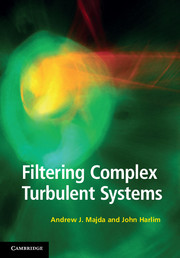Book contents
- Frontmatter
- Contents
- Preface
- 1 Introduction and overview: Mathematical strategies for filtering turbulent systems
- Part I Fundamentals
- Part II Mathematical guidelines for filtering turbulent signals
- 5 Stochastic models for turbulence
- 6 Filtering turbulent signals: Plentiful observations
- 7 Filtering turbulent signals: Regularly spaced sparse observations
- 8 Filtering linear stochastic PDE models with instability and model error
- Part III Filtering turbulent nonlinear dynamical systems
- References
- Index
6 - Filtering turbulent signals: Plentiful observations
from Part II - Mathematical guidelines for filtering turbulent signals
Published online by Cambridge University Press: 05 March 2012
- Frontmatter
- Contents
- Preface
- 1 Introduction and overview: Mathematical strategies for filtering turbulent systems
- Part I Fundamentals
- Part II Mathematical guidelines for filtering turbulent signals
- 5 Stochastic models for turbulence
- 6 Filtering turbulent signals: Plentiful observations
- 7 Filtering turbulent signals: Regularly spaced sparse observations
- 8 Filtering linear stochastic PDE models with instability and model error
- Part III Filtering turbulent nonlinear dynamical systems
- References
- Index
Summary
The difficulties in filtering turbulent complex systems are largely due to our incomplete understanding of the dynamical system that underlies the observed signals, which have many spatio-temporal scales and rough turbulent energy spectra near the resolved mesh scale. In this chapter, we develop theoretical criteria as guidelines to address issues for filtering turbulent signals in an idealized context. In particular, we consider the simplest turbulent model discussed in Chapter 5 with plentiful observations, that is, the observations are available at every model grid point.
In this idealized context, we will provide a useful insight into answering several practical issues, including:
As the model resolution is increased, there is typically a large computational overhead in propagating the dynamical operator and this restricts the predictions to relatively small ensemble sizes. When is it possible to filter using standard explicit and implicit solvers for the original dynamic equations by using a large time step equal to the observation time (even violating the CFL stability condition with standard explicit schemes) to increase ensemble size, yet still retain statistical accuracy?
If plentiful observations are available on refined meshes, what is gained by increasing the resolution of the operational model? How does this depend on the nature of the turbulent spectrum?
- Type
- Chapter
- Information
- Filtering Complex Turbulent Systems , pp. 72 - 93Publisher: Cambridge University PressPrint publication year: 2012



